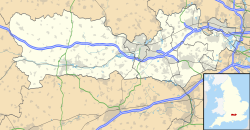This list of ancient woods in England contains areas of ancient woodland in England larger than 10 hectares (25 acres). The list is arranged alphabetically by ceremonial county.
Contents
- B
- Bedfordshire
- Berkshire
- Bristol
- Buckinghamshire
- C
- Cambridgeshire
- Cheshire
- City of London
- Cornwall
- Cumbria
- D
- Derbyshire
- Devon
- Dorset
- Durham
- E
- East Riding of Yorkshire
- East Sussex
- Essex
- G
- Gloucestershire
- Greater London
- Greater Manchester
- H
- Hampshire
- Herefordshire
- Hertfordshire
- I
- Isle of Wight
- K
- Kent
- L
- Lancashire
- Leicestershire
- Lincolnshire
- M
- Merseyside
- N
- Norfolk
- North Yorkshire
- Northamptonshire
- Northumberland
- Nottinghamshire
- O
- Oxfordshire
- R
- Rutland
- S
- Shropshire
- Somerset
- South Yorkshire
- Staffordshire
- Suffolk
- Surrey
- T
- Tyne and Wear
- W
- Warwickshire
- West Midlands
- West Sussex
- West Yorkshire
- Wiltshire
- Worcestershire
- See also
- Notes
- References
- External links
Natural England lists 53,636 ancient woodlands in its database as of 2024 [update] , comprising 39,223 ancient and semi-natural woodlands (ASNW), 14,339 ancient replanted woodlands (PAWS) and 64 ancient wood pastures (AWP). [1] Most of these are small, with 45,445 of the woods being below 10 ha in size. The breakdown by size (in logarithmic steps) for larger woods is: [1]
| Size (ha) | ASNW | PAWS | AWP |
|---|---|---|---|
| 10–21.5 | 3,206 | 1,648 | 2 |
| 21.5–46.4 | 1,279 | 937 | 0 |
| 46.4–100 | 406 | 419 | 0 |
| 100–215 | 86 | 140 | 0 |
| 215–464 | 19 | 44 | 0 |
| 464–1000 | 0 | 5 | 0 |


















